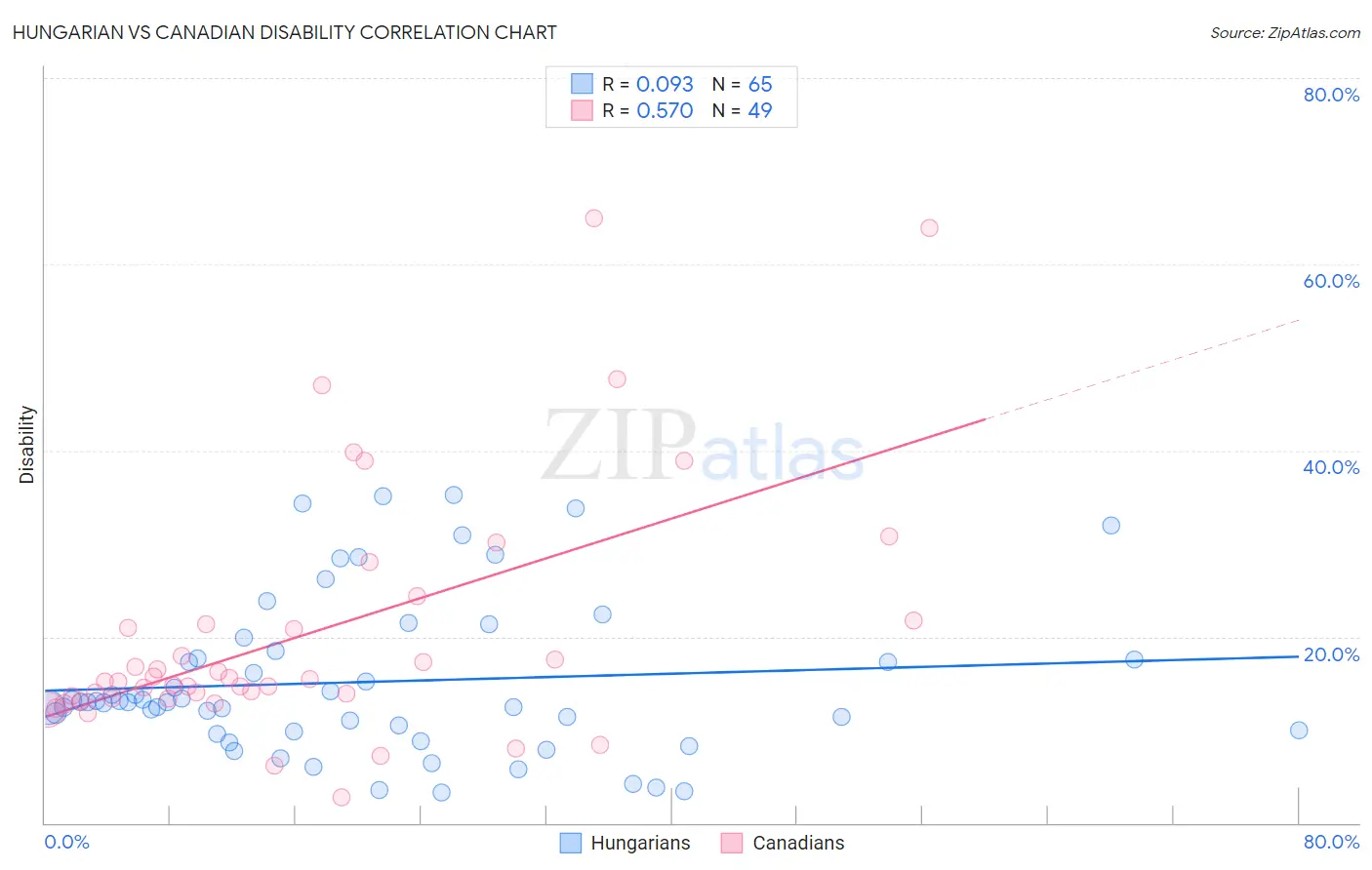Hungarian vs Canadian Disability
COMPARE
Hungarian
Canadian
Disability
Disability Comparison
Hungarians
Canadians
12.2%
DISABILITY
1.7/ 100
METRIC RATING
240th/ 347
METRIC RANK
12.4%
DISABILITY
0.4/ 100
METRIC RATING
259th/ 347
METRIC RANK
Hungarian vs Canadian Disability Correlation Chart
The statistical analysis conducted on geographies consisting of 486,180,390 people shows a slight positive correlation between the proportion of Hungarians and percentage of population with a disability in the United States with a correlation coefficient (R) of 0.093 and weighted average of 12.2%. Similarly, the statistical analysis conducted on geographies consisting of 437,501,505 people shows a substantial positive correlation between the proportion of Canadians and percentage of population with a disability in the United States with a correlation coefficient (R) of 0.570 and weighted average of 12.4%, a difference of 1.5%.

Disability Correlation Summary
| Measurement | Hungarian | Canadian |
| Minimum | 3.2% | 2.8% |
| Maximum | 35.2% | 65.0% |
| Range | 31.9% | 62.2% |
| Mean | 15.1% | 20.3% |
| Median | 12.9% | 15.2% |
| Interquartile 25% (IQ1) | 9.9% | 13.4% |
| Interquartile 75% (IQ3) | 18.1% | 21.6% |
| Interquartile Range (IQR) | 8.2% | 8.2% |
| Standard Deviation (Sample) | 8.3% | 13.5% |
| Standard Deviation (Population) | 8.3% | 13.3% |
Demographics Similar to Hungarians and Canadians by Disability
In terms of disability, the demographic groups most similar to Hungarians are Yugoslavian (12.2%, a difference of 0.0%), Polish (12.2%, a difference of 0.020%), Swedish (12.2%, a difference of 0.050%), British (12.2%, a difference of 0.11%), and Basque (12.2%, a difference of 0.11%). Similarly, the demographic groups most similar to Canadians are Slavic (12.4%, a difference of 0.060%), Immigrants from Laos (12.4%, a difference of 0.20%), Immigrants from Dominica (12.4%, a difference of 0.29%), Slovene (12.4%, a difference of 0.36%), and German Russian (12.3%, a difference of 0.69%).
| Demographics | Rating | Rank | Disability |
| Swedes | 1.8 /100 | #239 | Tragic 12.2% |
| Hungarians | 1.7 /100 | #240 | Tragic 12.2% |
| Yugoslavians | 1.7 /100 | #241 | Tragic 12.2% |
| Poles | 1.7 /100 | #242 | Tragic 12.2% |
| British | 1.5 /100 | #243 | Tragic 12.2% |
| Basques | 1.5 /100 | #244 | Tragic 12.2% |
| Liberians | 1.5 /100 | #245 | Tragic 12.2% |
| Swiss | 1.5 /100 | #246 | Tragic 12.2% |
| Indonesians | 1.4 /100 | #247 | Tragic 12.2% |
| Guamanians/Chamorros | 1.4 /100 | #248 | Tragic 12.3% |
| Carpatho Rusyns | 1.4 /100 | #249 | Tragic 12.3% |
| Sub-Saharan Africans | 1.4 /100 | #250 | Tragic 12.3% |
| Europeans | 1.4 /100 | #251 | Tragic 12.3% |
| Bermudans | 1.1 /100 | #252 | Tragic 12.3% |
| Belgians | 0.8 /100 | #253 | Tragic 12.3% |
| German Russians | 0.8 /100 | #254 | Tragic 12.3% |
| Slovenes | 0.6 /100 | #255 | Tragic 12.4% |
| Immigrants | Dominica | 0.6 /100 | #256 | Tragic 12.4% |
| Immigrants | Laos | 0.5 /100 | #257 | Tragic 12.4% |
| Slavs | 0.5 /100 | #258 | Tragic 12.4% |
| Canadians | 0.4 /100 | #259 | Tragic 12.4% |